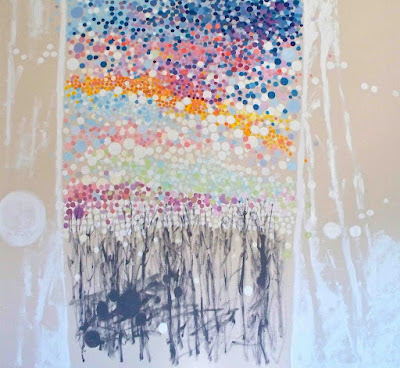

4" x 6" oil on panel
Like millions of others, I watched the Olympics. The human drama was there in time: life, death, hope, perseverance, defeat, triumph, achievement, the support of others. Empathetically, we watch with excitement and wonder. Olympic athletes take their sport to the level of art. In an interview with Evan Lysacek, American, the new gold medalist in figure skating, the host asked Dick Button (Olympic skating champion and TV skating analyst) if his performance achieved a balance between athleticism and artistry. Button confirmed it had and went on to tell that when Lysacek looks back on this time he will think not of the medal but know that he "skated well". Kaaren Anderson of the First Unitarian Church in Rochester, NY reflected on a similar theme after seeing an old gravestone inscribed with a person's name followed by, "She did a few things well." Initially it seemed insulting but after further consideration Anderson said that it was something to have the consistency and focus to do a few things well.
Like athleticism, painting requires dedication. Form in sports and art is very important for clarity. It displays control. That doesn't necessarily mean tight control but being able to execute form and still be fluid, fresh. Painting doesn't take place in linear time exactly and doesn't lend itself to time based media. It's quiet and still, although movement may be experienced in the expression, such as in brush stroke delivery. When teaching I have often compared the selection of a size and style of brush to choosing a golf club. Situations require different tools. Painting is intimate, one-on-one. Only blockbuster museum shows and the immersion of an image in culture, the Mona Lisa, for example, reach a kind of collective audience.
Scott Hamilton said to Lysacek that skating is about showing what you can do "with knives strapped to your feet." This is similar to a former professor telling the class that painting is amazing; we are pushing colored glue onto cloth with a stick with hairs on it.
It was disappointing that Lysacek's victory was challenged by Russia whose silver medalist, Evgeni Plushenko executed a quadruple jump and called the quad "the future of skating". Lysacek's performance was nearly perfect and the judges did not think that the ability to do a quad superseded other criteria. This situation made me think about the current state of painting. There are many artists and critics who dismiss the art form as passe because all two-dimensional pictorial rules have been broken. They say in the Internet Age, new media is where it's at. I disagree. Painting has been around since prehistoric times. Painters do not need to reinvent the wheel. Whether or not the future of skating lies in the quad, skating has its own inherent elements, its own language. You're not going to hit a ball skating; you're not going to use water in a warm state while skating; you're not going to walk on a tightrope while skating. Everything has limitations. Yet there is beauty that comes out of working within parameters. Skaters will always be compared to skaters of the past but also bring something of their own to the sport. Why does painting have to be blasted? Why do many look down their noses, dismissing it as conventional? It is ridiculous and frustrating.
Let's talk about the work. Gray Cloud and Afternoon are paintings that speak particularly in the singular. The gray cloud has a formidable presence like a character in a play. The viewer is asked to reflect on that presence which is mysterious and defies naming. Afternoon also has a singular cloud but it is set back, the trees assertive despite their scale. It's a view from my studio window of a bird sanctuary across the highway (I took out the highway). Small dots here and there are like touchstones.
I like the way Canadian skater Patrick Chan does other things in addition to skating like tennis, pilates, yoga, golf, and weekly piano lessons - talk about living life to its fullest! It reminds me of advice for life a mentor recently gave me, "Be well, live full, paint well." It is not unlike Button's for Lysacek, memories of "skating well". What would you like to remember and be remembered for doing well?








